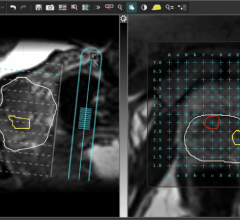
August 26, 2016 — The latest version of Elekta’s Monaco treatment planning software was recently highlighted in multiple presentations at the 58 th American Association of Physicists in Medicine (AAPM) annual meeting and exhibition, July 31-Aug. 4 in Washington, D.C. A treatment planning solution with gold-standard Monte Carlo accuracy and multicriteria optimization, Monaco supports radiotherapy techniques, including advanced 3-D, intensity modulated radiotherapy (IMRT), volumetric modulated arc therapy (VMAT) and highly-complex stereotactic treatments.
Monaco empowers users to attain accuracy without compromise for faster, more efficient treatment planning. Template sharing functionality complemented by Radiation Therapy Oncology Group (RTOG) and user-based integrated templates enable class solution planning and best practice-sharing across departments, organizations and professional communities.
“The latest version of Elekta’s Monaco software offers several enhancements to optimize patient workflow, including a significantly faster optimization time and template planning,” said Sotiri Stathakis, Ph.D., associate professor, radiation oncology and radiology at University of Texas Health Science Center in San Antonio, Texas. “These data demonstrate that Monaco software supports highly accurate treatment planning, using best-in-class Monte Carlo dose calculations, in a range of clinical environments.”
Recent presentations presented AAPM 2016 highlighting Monaco include:
“Differences in Lung Sparing in Deep Inspiration Breath-Hold and Free Breathing Breast Plans Calculated in Pinnacle and Monaco”
This presentation described five patients undergoing deep inspiration breath-hold (DIBH) breast radiotherapy. Breath hold and free breathing plans doses were initially determined using the Phillips Pinnacle system and re-calculated with Monaco to determine if there were significant differences. Researchers reported equivalent dose reductions for both systems, with observed lung doses that were significantly higher when calculated using the Monte Carlo algorithm in Monaco. The authors state that Monte Carlo calculation can provide insight into dose in the actual dose in lung for both breath hold and free breathing breast cancer patients treated with radiation.
“Monte Carlo Re-Evaluation of Volumetric-Modulated Arc Plans of Advanced Stage Nasopharyngeal Cancers Optimized with Convolution-Superposition Algorithm”
This study examined Monaco recalculation of 29 treatment plans for advanced-stage nasopharyngeal cancers (NPC). Results demonstrated that significant dosimetric differences in NPC treatment plans were observed between a convolution-superposition (CS) algorithm used in the Pinnacle system and the Monte Carlo calculations in Monaco software. Results indicated that PTV54-70Gy doses are higher and consistently predicted by Monte Carlo. The authors conclude that adjustments of the planning dose constraints to incorporate the physics differences from a conventional CS algorithm should be made when optimization is carried out directly with a Monte Carlo dose engine.
“SRS Dose Calculation Accuracy Comparison Between Pencil Beam and Monte Carlo Algorithms”
In this study, researchers evaluated 20 treatment plans that were generated using the iPlan system and calculated using the pencil beam algorithm. Computed tomography (CT) image sets along with the plan, doses and structures were exported to the Monaco treatment planning software (TPS) and the dose was recalculated using the same voxel resolution (a value on a regular grid in three-dimensional space) and monitor units. Benchmark data was also generated prior to patient calculations to assess accuracy of the two TPS against measurements using a micro-ionization chamber in solid water. Authors observed good agreement for measurements in water and noted that dosing differences varied up to 9.6 percent, concluding that Monte Carlo is a superior dose calculation algorithm.
“Comparison of Pinnacle and Monaco Dose Calculations of SBRT Treatments”
This study exported 14 patients’ files from the Pinnacle TPS to Monaco. All plans were recalculated within Monaco using a Monte-Carlo algorithm and prescription isodose volume to target volume ratio (PITV), R50 (the ratio of the volume irradiated to 50 percent of the prescribed dose to the volume of the planning treatment volume), conformity (a measurement of how well the dose was delivered to the target) and homogeneity indices were computed and used for stereotactic body radiation therapy (SBRT) plan evaluation. The mean PITV for Monaco increased 7 percent over Pinnacle, while the standard deviation increased from 0.047 to 0.076. The Homogeneity Index increased from 1.32 to 1.35. The Target Coverage decreased slightly from 0.98 to 0.97, with standard deviations for Homogeneity Index and Target coverage varying insignificantly by less than 0.2 percent. Researchers concluded that the increase PITV shows that the prescription dose volume increased in the treatment plans calculated by Monaco. The value of Monaco’s Monte Carlo calculation accuracy to stereotactic (small) field dosimetry was demonstrated by the authors. It was shown that dose inaccuracy greater than 5 percent (the level of clinical significance) is possible when non-Monte Carlo calculations are used, implying that Monte Carlo is valuable to patients being treated with small stereotactic fields.
“Validation of Monte-Carlo Beam Model for a Range of Small Fields in Heterogeneous Medium - A Measurement Based Study”
This study was designed to validate the Monaco Monte Carlo beam model by studying effects on three different types of phantoms selected to resemble the densities of lung, soft tissue and bone. Researchers concluded that the accuracy of dose calculation for the small fields in Monaco Monte Carlo algorithm was validated in the three different materials, and found that the results were consistent with measurement data.
For more information: www.elekta.com


 August 09, 2024
August 09, 2024 








